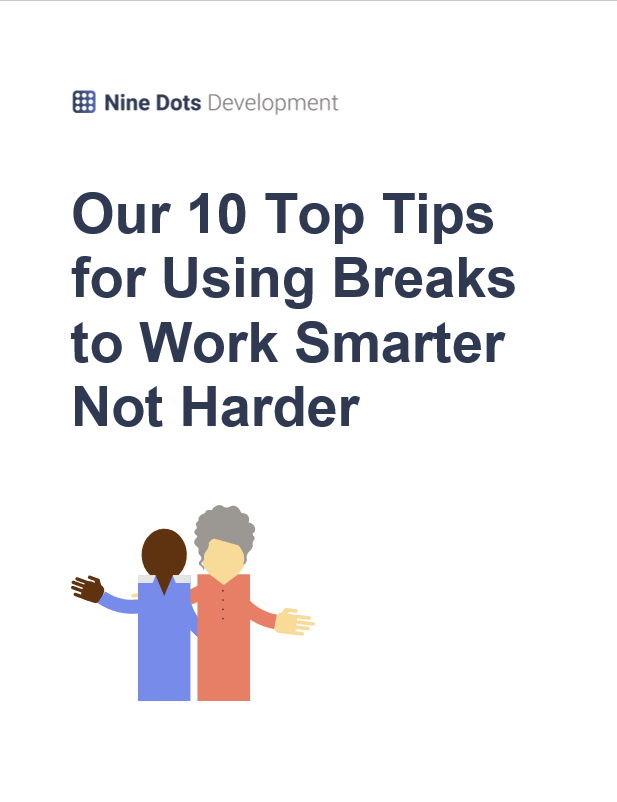Thursday 30 Sep 2021 Article
The TakeawayThe Counterintuitive Approach to Efficiency
Overwhelming Workloads
Part 3
#Workload #EmployeeWellbeing #MentalWellbeing #BetterWorkplace #AnnualLeave #StressAndPressure #Efficiency #PersonalDevelopment
The perfectly matched resource for this article...
Our 10 Top Tips for Using Breaks to Work Smarter Not Harder
Whatever the reason may be that your staff struggle to take breaks, we have collated ‘Our 10 Top Tips for Using Breaks to Work Smarter Not Harder’ into one PDF which you can send to your leaders and managers for them to distribute to their staff, or to send to your employees directly.
Download PDF!The Counterintuitive Approach to Efficiency
In our previous article, we explored the unspoken benefits of deadlines and how to use them as a motivational tool. However, it’s important for leaders and managers to not get too caught up in goals and deadlines and forget to look after their employees’ wellbeing.
In today’s article, we explore the psychology behind why staff should take breaks, employees’ break entitlement legislation, and how leaders and managers should encourage employees to take breaks and annual leave.
Why Breaks Are a Necessity, Not a Luxury
When staff have an overwhelming workload, they’re prone to not taking substantial breaks as they think that they don’t have time to do so. Whether they’re striving to hit a deadline, or are facing a tough, challenging task, staff can be tempted to force themselves to work well past the point of fatigue.
In reality, nobody can work at 100%, 100% of the time.
Psychology shows that the human brain can only focus for a maximum of 2 hours before needing a 20-30 minute break. If staff continue to work without a break after those 2 hours are up, they will lose concentration and won’t be able to complete tasks as efficiently as they could if they took a break then got back to work.
Taking breaks has countless benefits, including:
- Better concentration
- A boost in creativity
- Reduced presenteeism
- Lower absenteeism
- Greater job satisfaction
- Time for reflection
- A new, fresh perspective
- Ability to look at the bigger picture
- Produce higher quality work
- Better workplace morale
In addition to these 10 benefits, taking breaks - especially if staff get stuck on a particular task - allows their subconscious mind to work. Our brains have two functioning modes: focused, and diffused. When our brains are in the ‘diffused’ mode, they are more relaxed, almost in a ‘daydream’ state, and this is when we do most of our problem solving - how many times have you come up with a great idea or solved a mind-boggling problem whilst you’re in the shower, or driving? Having a break allows staff’s brains to go into the ‘diffused’ mode, allowing their subconscious to work.

Most importantly, breaks are vital for employees’ well-being. When constantly working with no proper breaks, staff often don’t realise how stressed they are until the end of the day. Taking regular breaks helps stop this stress from building up and getting overwhelming.
The Crucial Legislation Behind Allowing Staff Breaks
The 1998 Working Time Regulations legislation governs employees’ break entitlement at work. It states that, in general, all employees aged 18+ are entitled to:
- 11 consecutive hours’ rest in any 24 hours
- At least 20 minutes' break when they work for more than six hours
- Not work more than 48 hours per week on average (but employees may ‘opt-out’ of this to work longer hours)
So not only is giving staff breaks a good HR practice, it is actually a legal requirement. But even if it wasn’t, allowing staff time for rest and taking breaks is vital for both staff and the company.
Encouraging Employees to Take Annual Leave
As we explored in one of our previous articles, DFDS, Glassdoor, and Britain’s Healthiest Workplace all recently carried out surveys looking at the importance of rest and employees’ experiences with annual leave. The surveys found that:
- 79% of Brits return to work from holidays feeling significantly less stressed
- 30% of women and 27% of men have not booked a holiday in the past 12 months
- 40% of employees took a maximum of only half their annual leave
- The average employee takes just 62% of their allowance
- High stress and a lack of physical activity cause organisations to lose up to 27 days of productive time per employee each year
- Employees not taking annual leave has huge financial implications; the UK misses out on around £77.5 billion a year in loss of productivity due to mental and physical ill-health, often caused by stress
The best of the best leaders put employee wellbeing at the heart of their organisation and recognise the importance of encouraging annual leave.
{{ADVERT}}
On September 23rd 2014, Richard Branson, owner of Virgin Media, published an article that revealed that he was scrapping Virgin’s existing annual leave policy and instead, allowing his staff to "take off whenever they want for as long as they want". In his article, he stated that he made this bold move because of an article his daughter had forwarded to him about how Netflix had made a very similar decision.
"It is left to the employee alone to decide if and when he or she feels like taking a few hours, a day, a week or a month off, the assumption being that they are only going to do it when they feel 100% comfortable that they and their team are up to date on every project and that their absence will not in any way damage the business - or, for that matter, their careers! We should focus on what people get done, not on how many hours or days worked. Just as we don't have a nine-to-five policy, we don't need a vacation policy.”
Staff Reluctant to Take Breaks?
We’re all guilty of it - eating our lunch quickly at our desk and then working for the rest of our entitled lunch break, not taking any other breaks throughout the day.
Employees do this for a variety of reasons, one of them being that they feel guilty for taking a break even though they are entitled to it. To combat this, it’s crucial to actively encourage staff to take their break, get away from their computer, and to tell them that they won’t get in trouble for it. Another common reason is that staff believe that they are more productive when they keep working for hours on end when, as we have discussed in today’s article, that certainly isn’t true.
Whatever the reason may be that your staff struggle to take breaks, we have collated ‘Our 10 Top Tips for Using Breaks to Work Smarter Not Harder’ into one PDF which you can send to your leaders and managers for them to distribute to their staff, or to send to your employees directly. To download this PDF, please click here.
---
Until next time...
Our 10 Top Tips for Using Breaks to Work Smarter Not Harder
Whatever the reason may be that your staff struggle to take breaks, we have collated ‘Our 10 Top Tips for Using Breaks to Work Smarter Not Harder’ into one PDF which you can send to your leaders and managers for them to distribute to their staff, or to send to your employees directly.
Download PDF!Missed an article?
More from Overwhelming Workloads
